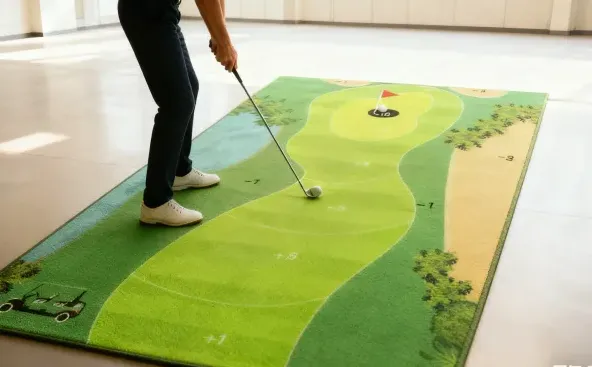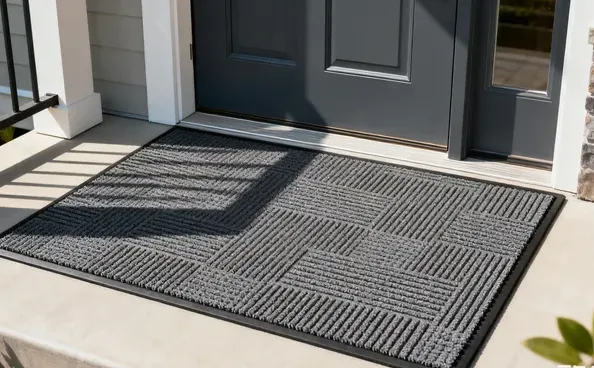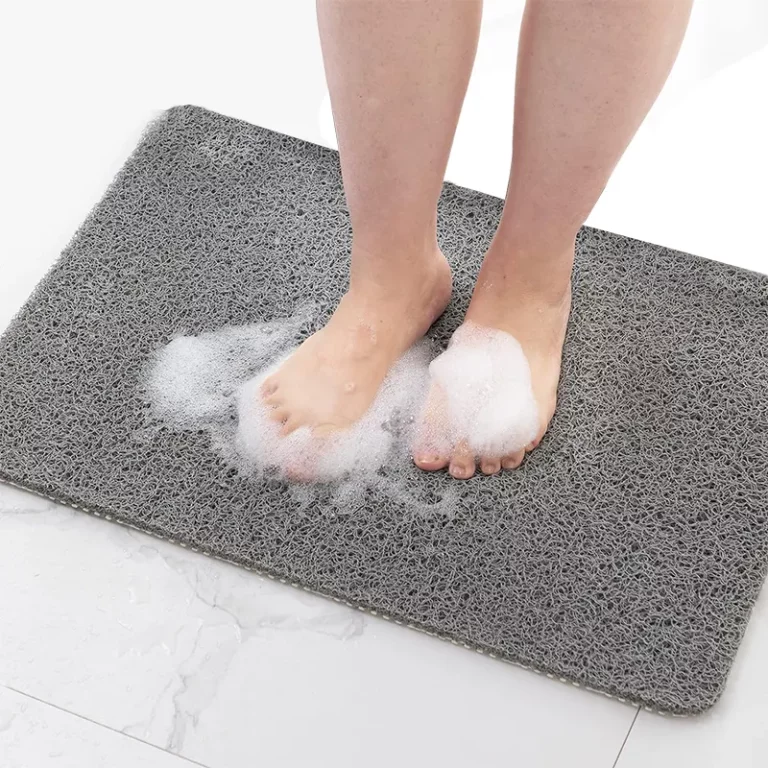I once slipped on water my dog tracked in. I worried about the damage to my floors. I needed a better way to manage wet paws.
A doormat made of fast-drying, water-absorbent material solves this problem. It traps moisture, keeps floors dry, and reduces the risk of slips. It also helps maintain a cleaner home.

I remember how tedious it was to wipe up puddles every time my dog ran inside. Once I found the right doormat, daily life got much easier. Let’s look deeper into some related questions.
What kind of rug will dogs not pee on?
I once placed a plush rug that seemed great, but my dog used it as a bathroom spot. It frustrated me. I realized certain materials are more inviting for accidents.
A rug that is water-resistant, odor-neutral, and easy to clean can deter dogs from peeing. Dogs are less likely to soil a surface that does not hold scent or feel inviting for marking.

Choosing a Pee-Resistant Rug
Dogs often pee on rugs for various reasons, including marking territory, anxiety, or confusion. I learned that the type of rug can influence this behavior. Let’s break down the factors:
1. Material Matters
- Indoor-Outdoor Fabrics
Rugs made for outdoor or patio use often repel moisture. Dogs might sniff them but typically are less drawn to pee on them because these rugs do not retain scent as easily. - Synthetic Fibers
Polypropylene or polyester rugs resist liquids better than natural fibers like wool or cotton. They’re also simpler to wash and quick to dry.
2. Backing and Grip
- Non-Skid Layer
A rug that slides around can cause stress or confusion for a dog, which may lead them to mark. A stable surface reduces anxiety. - Waterproof Backing
Some rugs have a waterproof membrane that keeps urine from soaking through to the floor. This helps limit lingering odors.
3. Easy Cleaning
- Machine-Washable
If your dog does have an accident, you can quickly wash the rug in a machine. This removes deep-set smells that might prompt your dog to pee there again. - Spot Cleaning
Some rugs have special coatings that let you wipe away spills. A simple solution of water and vinegar can neutralize odor without leaving strong scents dogs want to cover.
4. Rug Placement
- Location
Placing rugs in areas where dogs rarely go can reduce accidents. If a dog has free run of the house, a strategically located rug that doesn’t impede their usual paths might stay clean longer.
5. Behavioral Insights
- Consistency in Training
Even the best rug won’t help if your dog lacks house-training cues. Reinforcing good potty habits is crucial. - Vet Check
If your dog suddenly starts peeing inside, consult a vet. It could be a sign of urinary issues or stress.
Below is a short table comparing different rug options for pee resistance:
| Rug Type | Water Resistance | Ease of Cleaning | Potential Drawback |
|---|---|---|---|
| Polypropylene | High | Easy (Machine/Spot) | May feel less plush |
| Polyester | Moderate | Generally easy | Some varieties can trap odors |
| Indoor-Outdoor Mats | High | Quick hose-down | Might lack indoor-style comfort |
| Wool | Low | Tricky (Professional) | Absorbs moisture, retains smell |
Getting a pee-resistant rug is partly about picking the right materials and partly about reinforcing training. A dog that knows where to go will be less likely to soil a rug. Still, having a water-resistant rug as a backup can spare you constant cleanup. With time, you’ll find the perfect balance between style and practicality.
What doormat doesn’t get waterlogged?
I remember how standard mats stayed soggy for hours. My dog tracked mud right over them. It felt hopeless. Then I found mats specifically designed to dry quickly.
A quick-drying doormat1 made of microfiber or certain synthetic blends won’t stay waterlogged. They wick moisture away, preventing a damp surface. Many also have rubber backings to keep floors dry.
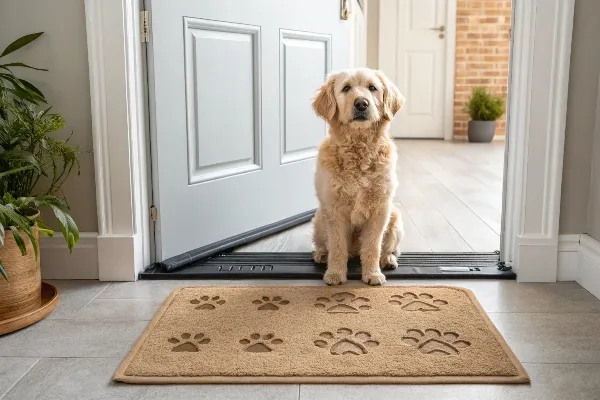
Preventing Excessive Moisture
When you have a wet dog running in from the yard, dealing with constant puddles is draining. If your doormat stays waterlogged, you never truly solve the issue. Let’s look at the solutions:
1. Absorbent Materials
- Microfiber
Microfiber strands soak up water quickly, acting like a towel under your dog’s paws. Some mats can hold several times their weight in water. - Chenille
Similar to microfiber, chenille mats have soft “noodles” that capture moisture. These mats often feel cozy for dogs, encouraging them to linger and dry off more thoroughly.
2. Drainage Designs
- Raised Patterns
Mats with ridges or channels direct water away, keeping the surface drier. Your dog stands on the raised pattern while water flows into grooves below. - Perforated Layers
Some doormats use dual-layer construction, allowing water to fall through holes into a lower reservoir. You can then empty or wash it.
3. Quick-Dry Feature
- Synthetic Blends
Many synthetic mats dry faster than cotton or jute. If you can shake out or wring them easily, that speeds the process. - Sunlight Exposure
Placing the mat in a sunny spot helps moisture evaporate. If you have a covered porch, check that it gets some airflow to avoid mildew buildup.
(Tip for Busy Dog Owners)
After a muddy walk, I sometimes rub my dog’s paws gently with an old towel before he steps on the doormat. That reduces how much water the mat has to handle and speeds overall drying.
4. Maintenance
Proper upkeep is crucial. If your mat remains damp for long periods, mold or odors can develop. A daily shake-out or brief hang to air dry can keep the mat fresh.
Investing in a doormat that doesn’t stay soggy is a small change that pays off. You’ll mop less, your floors stay safer, and your dog’s paws dry faster. My own transition from a generic rug to a chenille mat made a major difference in daily chores.
What type of rug is best when you have dogs?
I recall buying a plush decorative rug that my dog immediately stained with muddy paws. After repeated scrubbing, I looked for a more dog-friendly choice.
A rug that’s stain-resistant, durable, and easy to clean2 is best for homes with dogs. Synthetic fibers like polypropylene or polyester hold up to heavy traffic, resist odors, and handle frequent washing.
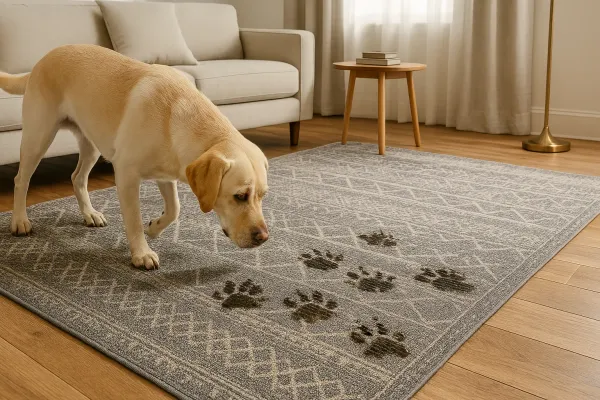
Selecting a Rug That Can Withstand Dogs
Owning dogs doesn’t mean you must sacrifice style in your home. With a bit of planning, you can find rugs that look good and stand up to wear. Let’s analyze what goes into the decision:
Material Breakdown
- Polypropylene
- Pros: Highly stain-resistant, easy to clean, budget-friendly.
- Cons: Might not feel as plush as wool. Some versions can flatten over time.
- Polyester
- Pros: Soft underfoot, often machine-washable.
- Cons: Can retain odors if not washed thoroughly.
- Nylon
- Pros: Very durable, colorfast, handles heavy dog traffic.
- Cons: More expensive. Might require spot cleaning for tough stains.
- Wool
- Pros: Natural fiber, fairly stain-resistant if treated.
- Cons: Requires professional cleaning, can hold odors if soiled repeatedly.
Construction and Pile
- Low Pile or Flatweave
Short fibers or flatweave designs collect fewer dog hairs, making vacuuming simpler. Long shag rugs might trap debris and dander. - Tight Weave
A dense weave is less likely to snag on a dog’s nails, reducing the chance of fraying.
Color and Pattern
- Multi-tone Patterns
Disguises minor stains or shedding. Solid light colors show every speck, while dark shades reveal hair or drool marks. - Slightly Mottled Designs
Blends small spots seamlessly, helpful for high-traffic pet areas.
Cleaning and Care
- Spot Cleaning
Look for instructions indicating easy spot cleaning with mild detergent. - Machine Washable
Some rugs (especially smaller ones) fit in standard washers. This is a game-changer for quick maintenance. - Professional Cleaning
Larger or wool rugs might need annual professional treatments to remove embedded dirt.
Table: Comparing Popular Rug Materials for Dog Owners
| Material | Durability | Ease of Cleaning | Comfort Level | Price Range |
|---|---|---|---|---|
| Polypropylene | High | Very Easy | Moderate | Low to Medium |
| Polyester | Medium-High | Easy | High | Low to Medium |
| Nylon | Very High | Moderate | Moderate-High | Medium to High |
| Wool | Medium | Difficult | High | Medium to High |
(Extension Insight)
If your dog tends to lie on the rug, consider placing a small dog bed or blanket nearby. This not only preserves your rug but gives your pup a soft spot they learn to prefer.
A well-chosen rug strikes the balance between looking attractive and withstanding canine antics. With the right fiber and design, you can keep your home cozy and stylish—without worrying about daily stains or snags.
What is the best doormat for dogs?
I used to buy random doormats, hoping they would do the trick. They rarely lasted. Eventually, I figured out what matters most when dealing with dogs and their messes.
A doormat designed for pets should have strong absorption, a non-slip base, and easy washability. Materials like chenille, microfiber, or rubber blends work best to capture debris and water from paws.
Must-Haves for an Effective Dog Doormat
Doormats play a pivotal role in keeping your home clean. With dogs, you need more than a standard mat. Let’s outline the top features that matter:
1. Absorbency
- Chenille Strands
These create a plush surface that wicks moisture instantly. After a quick run outside in the rain, your dog’s paws come in contact with countless fibers that soak up water. - Microfiber
Microfiber mats dry fast, remain lightweight, and can handle repeated washes.
2. Non-Slip Backing
- Rubber or Latex
Dogs can step forcefully or push off quickly. A stable mat prevents slipping for both you and your pup. A doormat that slides is both ineffective and potentially hazardous. - Weighted Edges
Some mats have heavier edges so corners do not curl. This reduces tripping risks.
3. Easy Cleaning
- Machine Washable
Look for mats labeled safe for washers if possible. This convenience cuts down your workload. - Quick Hose-Down
If the mat is large or made of rubber, being able to rinse it outside is a plus. A thorough spray removes mud and fur in seconds.
4. Stain Resistance
Over time, doormats can develop discoloration from muddy prints and general wear. Quality mats use stain-resistant fibers that look fresh longer. Even if your dog tracks in soil repeatedly, you can wash the mat without permanent blotches.
5. Durable Binding
Since dogs may scratch or paw at the mat, the edges and stitching should be robust. Flimsy mats can fray quickly, losing shape and usability. Aim for mats with reinforced borders.
When I finally settled on a chenille doormat with a rubber underside, the difference was apparent. My dog’s muddy paw prints were mostly absorbed. The mat stayed put, and a quick toss in the wash every week kept it pristine. No more hasty floor wipe-downs or puddles near the entrance.
Finding the best doormat for dogs combines function, comfort, and longevity. It keeps your home neater, saves time on cleaning, and ensures your pet has a safe, slip-free spot to transition from outdoors to indoors.
Conclusion
The right doormat for wet dogs prevents waterlogged floors, resists stains, and handles active paws. Combining quality materials, absorbent fibers, and a sturdy grip, these mats keep your entry dry and your home peaceful.

